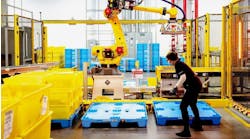By Jason Ray, CEO and co-founder of Paperless Parts
The COVID-19 pandemic forced custom-part manufacturers to slow or shut down
Paperless Parts' Jason Ray
productions—a shift that has posed several obstacles and, surprisingly, even a few opportunities.
During this time, manufacturers gained more flexibility to step back and assess their business, a critical exercise that often falls to the wayside amid a demanding work schedule. Now, as shops start to reopen, it’s more important than ever to take this extra measure. When the world fully resumes operations, the pressure to modernize—coupled with post-COVID-19 complexity—will only grow.
Digital transformation may seem like a daunting task for custom-part manufacturers. They may not know where to invest within their business—or making any financial investments may not feel feasible at this time. However, there are steps that manufacturers can take to improve and streamline processes.
By finding the right tools and partners, and embracing the following best practices, custom-part manufacturers can ensure they are well-positioned to win jobs and succeed in the industry’s new normal.
Vet third-party vendors, suppliers and providers
The supply chain has been significantly impacted by the COVID-19 pandemic. Now, as the dust starts to settle, custom-part manufacturers should take time to make their supply chain as strong as possible—especially before any resurgence of risk or the next crisis arises. Custom-part manufacturers should evaluate their current supply chain, starting with everyone involved. There is a chance some suppliers have closed or reduced to limited capacity, leaving gaps. Manufacturers should talk to existing suppliers about their plans to return to work. If custom-part manufacturers need to find replacements, they should start by turning to other vendors in their supply chain to see if they can be used to fill gaps.
That said, as custom-part manufacturers move forward, no one wants their entire supply chain to hinge on one vendor. For every supplier and vendor involved, manufacturers should have a backup in mind. If one supplier goes out of commission, manufacturers must have a plan B already vetted and ready to engage. It’s also important to diversify the supply chain—ensuring every supplier or vendor isn’t in just one part of the country, for example. In the case of COVID-19, different regions were impacted and regulated differently.
As custom-part manufacturers assess suppliers and vendors, they should also consider whether each company is a true partner. Are they communicative and responsive? Are they transparent about the state of their business and their return-to-work strategy? Now that shops have a bit more time, they can look closer and build a stronger, more resilient supply chain that will help them weather the new normal more confidently.
Communicate capabilities to customers and prospects
Custom-part manufacturers should always consider how they can be good partners to their customers. It’s important to communicate three items:
- Current availability and any adjusted hours
- Current capacity and capabilities
- Commitment to continue serving customers
Some manufacturers may be coming back at reduced capacity. Others may have implemented new capabilities and offerings they didn’t have before. If so, it’s important for customers and prospects to know about it. Existing customer relationships are more critical than ever to keep businesses afloat. Custom-part manufacturers should not wait for customers to reach out with questions—the onus is on them to reach out about their status. To start, manufacturers can send out a tailored email to their customer database, assuring them of availability, new offerings to enhance their business relationship, and commitment to returning to normal—or thriving in the new normal.
Assess your internal processes
Owners should assess, audit and streamline internal processes. Inefficiency often goes unresolved because it is tied to legacy processes or systems and can oftentimes feel like an inconvenience rather than a serious hazard to a business. This overlooked inefficiency can cause significant loss within an organization.
To identify which internal processes are working (and which aren’t), custom-part manufacturers can start by running process-mapping exercises. During this examination, manufacturers can go through their processes and define what a business entity does, who is responsible for it, what standard should be met, and how the success of the process is determined. This exercise could also be coupled with a Kaizen event, through which employees can highlight inefficiencies in their current day-to-day tasks. (A Kaizen event involves a team workshop, wherein the team can set specific goals for an area that needs improvement. It can include training, data collection, brainstorming and strategizing.) With direct input from employees on the front lines, manufacturers will be able to better target problem areas and processes.
As custom-part manufacturers consider how to address inefficiencies they discover, they should look to trusted remedy methods. A tool as simple as a new whiteboard or tablet out on the warehouse floor could yield hours of time-savings each month. Manufacturers can also look to digital solutions that address the root of the problem. If scheduling issues are being caused by inaccurate quoting or slow order-processing, for example, that is the area where they need to invest.
Use the power of automation
The goal of Industry 4.0 and digital transformation is to achieve a higher level of efficiency, reduce bottlenecks, increase production speed and trim costs. Custom-part manufacturers can automate even just one internal process and see major impacts across the entire organization.
Take quoting, for instance. A lot of manual work goes into tracking, managing and reviewing each RFQ—and customer data is often spread across systems and people, which creates bottlenecks and inconsistencies. By automating quoting, custom-part manufacturers can significantly reduce the need for data entry, freeing up their most experienced employees for more strategic work. It also improves the consistency of quotes, so they are closer to the true cost, which enhances business planning.
Most importantly, optimized quoting supports just-in-time manufacturing and expedites the customer experience—two staples of Industry 4.0. Custom-part manufacturers that provide quotes faster will be able to process more jobs, gaining a leg up in the new normal.
As the manufacturing industry revs up again, job shops must shift their mindset from surviving to thriving. Despite unknowns around the new normal—and unforeseen challenges and opportunities that await within—taking the time to invest in the business will prepare shops for a long-term success.




